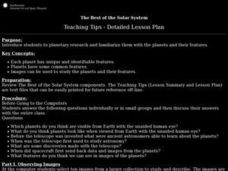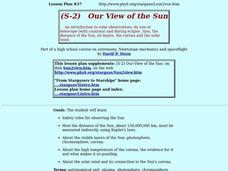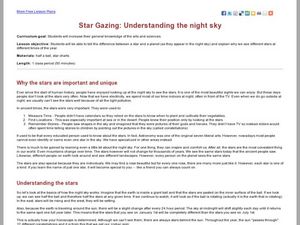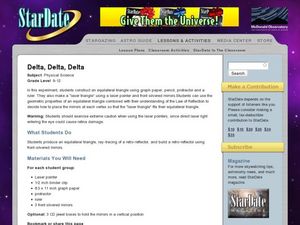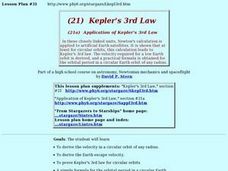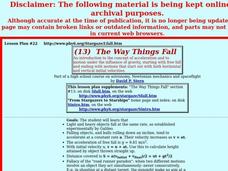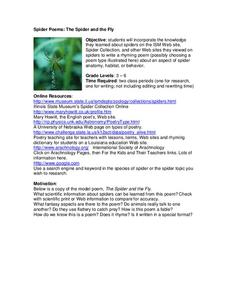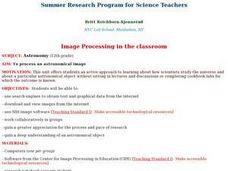Curated OER
The Best of the Solar System (Grades 6-8)
Learners are introduced to planetary research and become familiar with the planets and their features. They view images of the planets, and fill in an information chart which is imbedded in this plan.
Curated OER
Our Solar System
Students investigate the coincidental parade of planets and witness dramatic views of the solar system by researching websites and participating in online activities. They write about their findings.
Curated OER
Moon Phase Bulletin Board Lesson Plan
Students create a poster board showing the phases of the moon. They use the Internet to research the different phases and examine the calendar. They discuss what patterns they notice occuring.
Curated OER
Our View of the Sun
High schoolers are introduced to safety rules for observing the Sun, how the distance of the Sun is measured using Kepler's Laws and identify the visible layers of the Sun. They discuss solar eclipses and view images of eclipses using...
Curated OER
Spider Poems: The Spider and the Fly
Students review the information they gathered on different websites to write a poem about spiders. They use other websites to gain more information if needed. They share their poem with the class.
Curated OER
Hubble Space Telescope
High schoolers investigate the history and use of the Hubble Space Telescope. They take a quiz in order to establish in any prior knowledge. Students conduct research to find information in conjunction with participating in class...
Curated OER
Solstice And Equiniox Curriculum
High schoolers engage in a lesson that investigates finding the dates of the solstices and equinoxes. They define the terms related to the concept and conduct research in order to explain the physical occurrences. They also relate to how...
Curated OER
Reading and Listening for Information
Students practice their reading and listening skills in order to obtains accurate information. In preparation for a Moon, Mars, and Beyond Mission project, they read short stories about planet and moon mythology then answer questions...
Curated OER
High in the Sky
Sixth graders explore the concept of constellations. In this constellations lesson plan, 6th graders research Internet and print sources regarding constellations, particularly those that are named for mythological creatures. Students...
Curated OER
Star Gazing: Understanding the night sky
Students observe star charts to understand the difference between a star and a planet. In this star lesson plan, students also explain why we see different stars at different times of the year.
Curated OER
Individual Horizontal Sundial 2: Cloud/Rain Activity
Students create a sundial to measure local apparent time as it relates to the position of the sun in the sky. In this sundial lesson, students cut and glue gnomon to a sheet of thin cardboard. Students then set the sundial in an...
Curated OER
Delta, Delta, Delta
High schoolers construct equilateral triangles and a 'laser' triangle. In this reflection lesson students build a retro-reflector using mirrors.
Curated OER
Kepler and his Laws
Pupils examine Kepler's Laws. They confirm Kepler's 3rd law by comparing orbital periods and mean distances for all major planets and study conic sections, qualitatively.
Curated OER
Newton's Theory of Universal Gravitation
High schoolers explore how Newton tied together the gravity observed on Earth and the motion of the Moon. They apply an earlier lesson plan about centripetal forces.
Curated OER
Kepler's 3rd Law
Learners derive the velocity in a circular orbit of any radius. They derive the Earth escape velocity and prove Kepler's 3rd law for circular orbits # A simple formula for the orbital period in a circular Earth orbit of given radius.
Curated OER
The Way Things Fall
Learners explore concept of acceleration and motion under the influence of gravity, starting with free fall and ending with motions that start out with both horizontal and vertical initial velocities.
Curated OER
Planets Curriculum
Students complete an in-depth study of the known planets in the solar system. As a class, students identify the planets that are known in the universe, in the night sky. They explain the differences between planets and stars and the...
Curated OER
Stellar Lunar Curriculum
Students engage in a lesson that covers the concept of different phases of the moon. They name the cycles of the phases of the moon while using flashlights to simulate the light of the sun. They research information about several...
Curated OER
Solstice and Equinox
Learners identify the dates of the solstices and equinoxes and how they relate to the various seasons on Earth. After discussing how the solstice and equinox affect the seasons, students use their bodies to demonstrate the how each...
Curated OER
The Spider and the Fly
Students incorporate the knowledge they learned about spiders on the ISM Web site, Spider Collection, and other Web sites they viewed on
spiders to write a rhyming poem (possibly choosing a poem type illustrated here) about an aspect of...
Curated OER
Seeing Interference Fringes with a Telescope
Students construct an interferometer using a simple telescope. In this physics lesson, students explain how light waves create the fringe patterns. They observe patterns made by different objects in the sky and compare them.
Curated OER
Image Processing in the Classroom
Twelfth graders determine how scientists study the universe and particular astronomical objects using Internet research, images and NIH software. They work in groups to examine and use imaging software as they study astronomical objects.
Curated OER
Colonizing the Stars
Students compare and contrast the size, composition and surface features of the nine planets of our solar system with the possible sizes and compositions of extra -solar planets.
Curated OER
Our Home in the Milky Way
Learners gain appreciation of the vastness of our galaxy by viewing an applet about the Milky Way. Students hypothesize about how long it would take to get from Earth to Pluto.
Other popular searches
- Astronomy and Space Science
- Space Science Astronomy
- Science Astronomy Stars
- Earth Science Astronomy
- Science Astronomy Graphing
- Life Science Astronomy
- "Astronomy and Space Science
